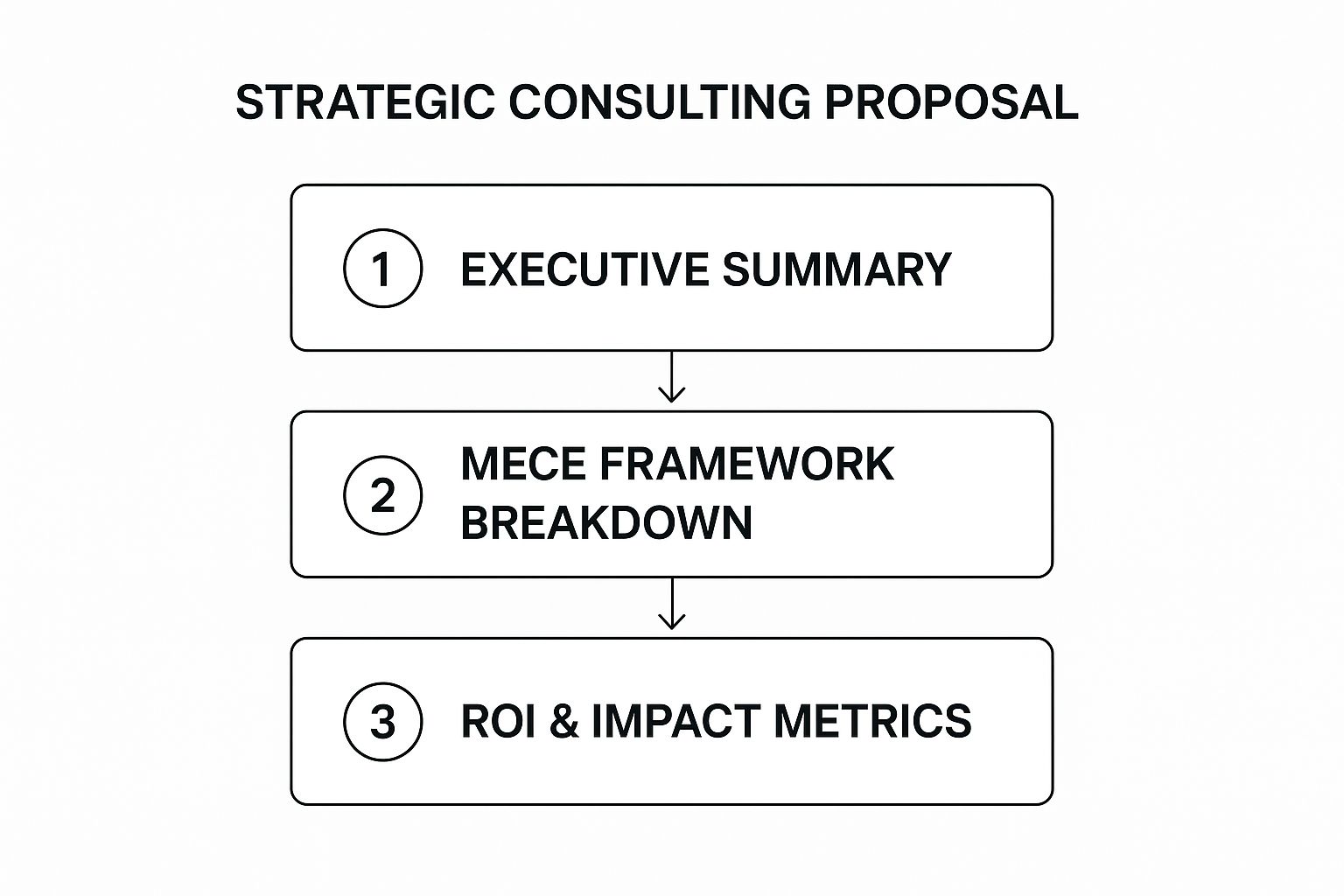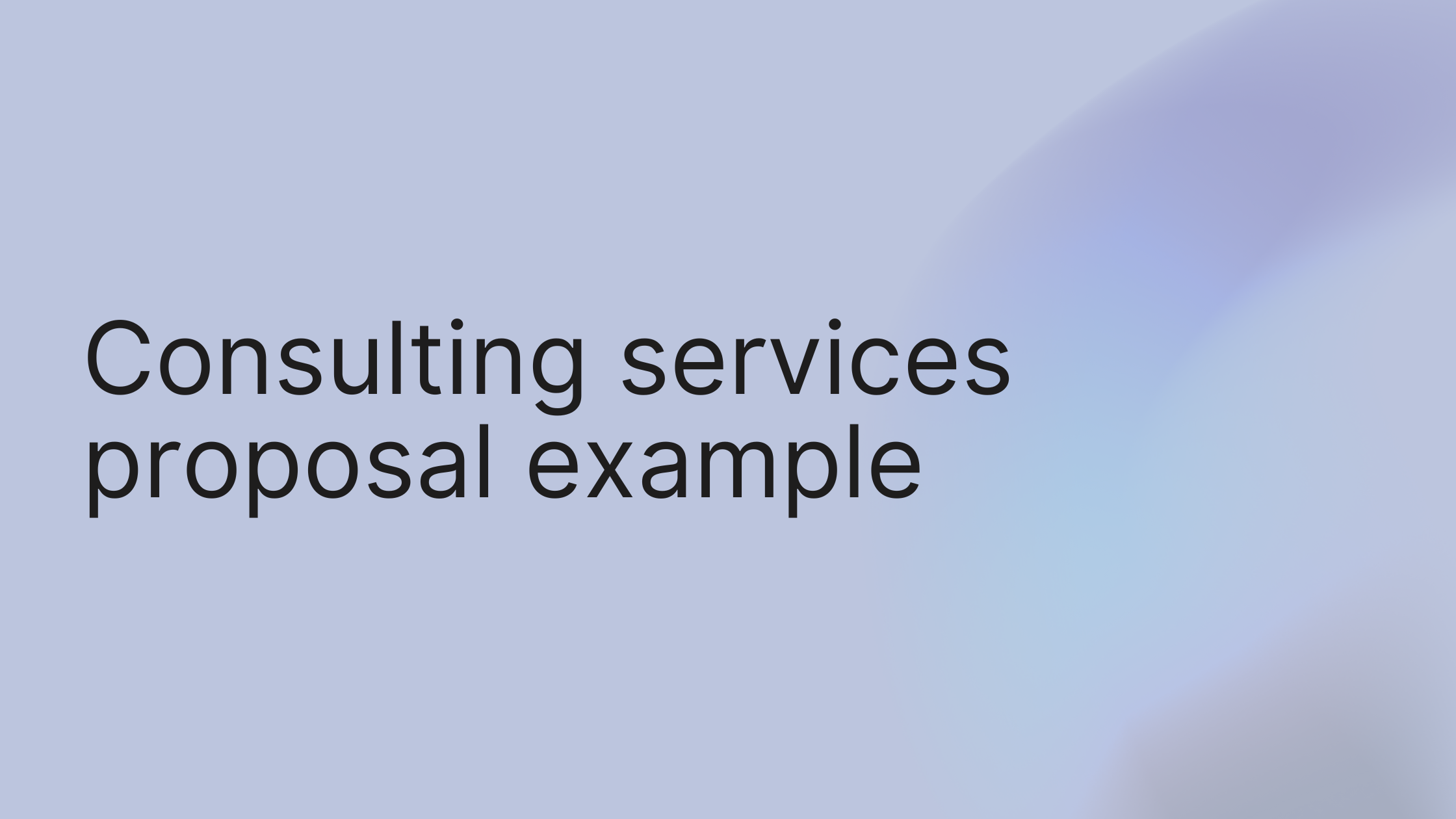Staring at a blank page, trying to write a proposal that will land a major client? That sinking feeling when you pour hours into a document only to be met with silence is all too familiar. You know your consulting services deliver massive value, but if your proposal doesn't communicate that, you’ll never get the chance to prove it.
The quick win? Stop starting from scratch. Adopt a proven framework. By structuring your proposal like a top-tier firm, you can instantly shift the conversation from cost to value.
In this guide, we'll deconstruct five powerful consulting services proposal examples, from giants like McKinsey to specialized boutique firms. We’ll provide actionable, step-by-step guidance to build proposals that not only look professional but strategically persuade clients to sign. You'll learn the replicable methods needed to articulate your value, build trust, and close more deals.
1. McKinsey & Company Management Consulting Proposal
Struggling to articulate the immense value of a complex strategic project in a way that executives will actually sign off on? You’re not alone. The biggest hurdle is often translating your deep analysis into a clear, compelling business case. The McKinsey-style proposal framework provides a quick win by forcing you to structure your thinking with relentless logic, ensuring every point directly supports a high-level, data-backed conclusion.
This approach, popularized by consulting giant McKinsey & Company, is the gold standard for high-stakes strategic initiatives. It moves beyond a simple services list to present a structured, hypothesis-driven argument. This consulting services proposal example is built on the MECE (Mutually Exclusive, Collectively Exhaustive) principle, ensuring your analysis is thorough and without overlap.
Strategic Breakdown and Analysis
The core of this proposal style is its rigorous, logical flow. It doesn’t just present facts; it builds a case. This method is exceptionally effective for projects like digital transformations, market entry strategies, or major organizational restructuring where the stakes are high and the path forward is complex.
Step 1: Start with a Hypothesis: Begin with a central hypothesis about the client's problem and proposed solution. For example: "By optimizing its supply chain with AI-driven demand forecasting, the client can reduce inventory costs by 20% and improve delivery times by 15% within 18 months."
Step 2: Apply the 'So What?' Test: Every piece of data, chart, and statement must answer the question, "So what?" If a data point doesn't directly support the central hypothesis or lead to a clear recommendation, it's cut. This ruthless editing keeps the proposal focused on what truly matters to the client's bottom line.
Step 3: Structure the Argument: Use Barbara Minto's Pyramid Principle, where the main recommendation is stated upfront in the executive summary, followed by supporting arguments and data grouped logically.
Pro Tip: When building your argument, structure your supporting points to be Mutually Exclusive (each point is a distinct idea) and Collectively Exhaustive (all points together cover the relevant issues). This MECE framework prevents confusing overlaps and ensures you haven't missed a critical angle.
The Proposal's Logical Flow
The power of this framework lies in its sequential logic, guiding the client from a high-level summary to the detailed impact. This process ensures clarity and builds confidence at each stage.

This visual illustrates the proposal's logical flow, starting with the Executive Summary, breaking down the problem with the MECE framework, and concluding with concrete ROI and impact metrics.
Actionable Takeaways
To implement this method, focus on a clear roadmap with defined outcomes. Include specific Key Performance Indicators (KPIs) and an implementation timeline that highlights quick wins to build early momentum. For high-impact consulting projects, integrating your project management and client communication is key. Learn more about how a CRM can streamline consulting engagements and keep your projects on track.
2. Deloitte Digital Technology Consulting Proposal
Ever pitched a complex tech implementation only to be met with blank stares when you get to the technical details? You know the cloud migration will revolutionize their operations, but you’re losing the executives in a sea of jargon. The quick win is to frame technology not as an IT cost center, but as a business growth engine. The Deloitte Digital-style proposal excels at this, translating dense technical requirements into tangible business outcomes.
This approach, championed by firms like Deloitte Digital and Accenture Interactive, masterfully blends deep technical expertise with strategic business insight. It’s designed for projects where technology is the core driver of change, such as ERP implementations or digital transformations. This consulting services proposal example moves beyond specs and features to focus on user adoption, agile delivery, and measurable performance improvements, ensuring tech projects deliver real-world value.

This visual highlights the model’s focus on integrating business goals with a phased, agile technology roadmap, covering everything from initial discovery and user experience design to full-scale deployment and ongoing optimization.
Strategic Breakdown and Analysis
The strength of this proposal is its practical, phased approach. It acknowledges that large technology projects are inherently uncertain and builds in flexibility. This methodology is perfect for CRM deployments, cloud migrations, or e-commerce platform developments where adapting to user feedback and technical challenges is crucial.
Step 1: Frame the Business-First Case: Start by anchoring the technology solution to a core business problem. Instead of leading with "We will implement Salesforce," lead with "We will increase sales team efficiency by 30% by deploying a customized CRM that automates lead scoring and reporting."
Step 2: Propose an Agile Rollout: Break the project into manageable sprints or phases, often including a pilot or proof-of-concept. This de-risks the project for the client, provides early wins, and allows for adjustments based on real-world feedback.
Step 3: Emphasize User Experience (UX): Heavily outline how the technology will be intuitive and valuable for the end-users. This is a critical success factor for any new system. For example, in growlio's proposal builder, you can see a UI callout for "Client View" which shows exactly what the client will see, improving clarity.
Pro Tip: When proposing multiple technology options, present them in a comparison table that clearly outlines the trade-offs. Include criteria like upfront cost, long-term TCO (Total Cost of Ownership), scalability, implementation time, and vendor support to help the client make an informed business decision, not just a technical one.
The Proposal's Logical Flow
The power of this framework lies in its pragmatic and transparent structure. It guides the client from a high-level strategic goal to a detailed, step-by-step implementation plan, building trust and demonstrating technical competence.
Actionable Takeaways
To use this model, structure your proposal around a clear, multi-phased roadmap. Define the scope, deliverables, and success metrics for each phase, especially for an initial proof-of-concept. For complex tech initiatives, managing stakeholder communication and technical documentation is paramount. See how a tool like growlio can centralize client collaboration and keep your technical projects on schedule.
3. Boutique Specialty Consulting Proposal
Feel like your deep, niche expertise gets lost in generic proposal templates that don't do it justice? You’re not just another consultant; you’re a specialist. The primary challenge is communicating this unique value without appearing too small or limited. A boutique-style proposal offers a quick win by shifting the focus from corporate scale to personalized, expert-driven solutions, allowing your deep knowledge to become the main selling point.
This approach is championed by independent experts and specialized firms who build their reputation on targeted expertise rather than broad-stroke strategies. Unlike one-size-fits-all documents, this consulting services proposal example is a bespoke instrument designed to showcase deep industry knowledge, a history of solving specific problems, and a highly personal service model. It’s perfect for demonstrating how your focused skill set delivers results that larger, more generalized firms often can't.
Real-World Use Case: The ESG Reporting Specialist
A small consulting firm specializing in Environmental, Social, and Governance (ESG) reporting struggled to compete against large accounting firms. Their generic proposals were getting lost. They pivoted to a boutique-style proposal that led with a hyper-relevant mini-case study. Instead of just listing their services, the first page detailed how they helped a similar mid-cap manufacturing company navigate new SEC climate disclosure rules, reducing their compliance risk by 40% and improving their investor relations score. This focused proof point immediately established credibility and led to a 60% increase in their close rate.
Strategic Breakdown and Analysis
The power of a boutique proposal lies in its authenticity and laser-like focus. It replaces broad claims with specific, verifiable evidence of expertise. This approach is highly effective for services like healthcare compliance consulting, regulatory guidance for financial institutions, or sustainability reporting for energy companies, where industry-specific nuance is everything.
Step 1: Lead with Niche Credibility: Start by immediately establishing your credentials within the client's specific micro-industry. This isn't just about listing past jobs; it's about showcasing specific certifications, publications, or conference presentations relevant to the client’s unique challenge.
Step 2: Use Hyper-Relevant Case Studies: General case studies won't work. Detail a project with a client facing an almost identical problem, like the ESG example above.
Step 3: Emphasize Direct Access: Highlight that the client will be working directly with the expert, not a junior analyst. This personal attention is a major differentiator and a key value proposition against larger competitors.
Pro Tip: Use an "Industry Snapshot" section early in your proposal. Briefly summarize the key regulations, market trends, or technological shifts impacting the client's specific niche. This immediately demonstrates that you understand their world and aren't just applying a generic framework.
Actionable Takeaways
To execute this style, frame your entire proposal around the client's specific context. Ditch corporate jargon in favor of the client's industry-specific language. Offer flexible engagement and pricing options, such as project-based fees, retainers, or even phased milestones, to show you can adapt to their needs. For specialized consulting, showcasing your organized approach is critical. See how you can use a CRM for consultants to manage bespoke client workflows and deliver that promised personal touch.
4. Process Improvement and Lean Six Sigma Consulting Proposal
Are your operational processes plagued by hidden bottlenecks, costly errors, and frustrating inefficiencies that eat into your profits? The core challenge is often proving that a disciplined, methodological approach can deliver tangible ROI. A Lean Six Sigma proposal offers a quick win by presenting a data-driven, systematic plan to eliminate waste and variability, promising measurable improvements that leadership can’t ignore.
This approach, pioneered by Motorola and famously scaled by General Electric, is the benchmark for achieving operational excellence. It combines Lean's focus on waste elimination with Six Sigma's statistical methods for reducing defects. This consulting services proposal example is not just about suggesting changes; it’s about creating a culture of continuous improvement backed by rigorous data analysis and proven problem-solving frameworks like DMAIC (Define, Measure, Analyze, Improve, Control).

Strategic Breakdown and Analysis
The strength of a Lean Six Sigma proposal lies in its clear, evidence-based methodology. It’s highly effective for manufacturing optimization, healthcare patient flow, and financial services automation, where even small process improvements can yield massive financial returns.
Step 1: Define the Problem with Data: Start by defining the problem with hard numbers. For example: "A leading financial services firm is experiencing a 15% error rate in its manual loan-processing workflow, leading to an estimated $2M in annual rework and compliance risks."
Step 2: Outline Your Methodology: Detail a specific framework, like DMAIC or DMADV, showing the client exactly how you will systematically identify root causes and implement lasting solutions. It moves beyond guesswork into statistical process control.
Step 3: Focus on Measurable Impact: Center the proposal on quantifiable outcomes. Success is defined by metrics like reduced defect rates (e.g., from 30,000 Defects Per Million Opportunities to under 3.4), decreased cycle times, and direct cost savings.
Pro Tip: Propose a small-scale pilot project first. For instance, apply Lean principles to a single manufacturing cell or one administrative workflow. This demonstrates quick value, builds trust, and secures buy-in for a larger, more comprehensive rollout.
The Proposal's Logical Flow
A Lean Six Sigma proposal guides the client through a structured journey from problem identification to a sustainable, continuously improving state. It builds confidence by showcasing a proven, repeatable methodology.
This video explains the core principles of Lean Six Sigma, illustrating how the methodology is applied to solve complex operational challenges and drive efficiency.
Actionable Takeaways
To make this proposal effective, include clear before-and-after metrics and address the critical element of change management. Your plan should detail employee training, new standard operating procedures, and a governance structure for ongoing improvement. A smooth transition is vital, which begins with a structured onboarding process. Learn more about effective client onboarding strategies for consulting projects to ensure your improvement initiatives start strong.
5. Human Resources and Organizational Development Consulting Proposal
Finding it tough to prove the ROI on “soft” initiatives like culture change or leadership development? You're not the only one. The main challenge is quantifying the impact of human capital improvements in a way that resonates with finance-focused executives. A proposal modeled after those from Gallup or Korn Ferry offers a quick win by framing people-centric projects with hard data and behavioral science, linking them directly to business outcomes like retention and productivity.
This type of proposal moves beyond listing workshops and training sessions. It presents a comprehensive diagnostic and a clear roadmap for organizational change. This consulting services proposal example is perfect for demonstrating value when tackling intangible but critical issues like employee engagement, talent management, or post-merger cultural integration. It’s built on a foundation of organizational assessment and data-driven insights.
Strategic Breakdown and Analysis
The strength of this proposal lies in its people-first, data-backed approach. It doesn't just promise a better workplace culture; it outlines how to measure and achieve it. This method is highly effective for projects like overhauling a performance management system to boost retention or launching a D&I initiative to foster innovation and expand the talent pool.
Step 1: Lead with a Diagnostic: Begin not with a solution, but with a thorough organizational assessment. Propose using employee surveys, leadership interviews, and focus groups to establish a clear baseline. For example: "An initial diagnostic will identify key drivers of disengagement, which are hypothesized to cost the company $1.5M annually in avoidable turnover."
Step 2: Use Behavioral Metrics: Instead of vague goals, use concrete metrics for "soft" skills. Connect leadership behaviors to employee engagement scores, and engagement scores to performance KPIs like sales growth or customer satisfaction.
Step 3: Plan for Sustainability: Focus on embedding change. Include plans for reinforcing new behaviors, aligning leadership, and creating feedback loops to ensure the transformation lasts long after the initial project is complete.
Pro Tip: Use a “Current State vs. Future State” framework. Clearly map out the current challenges (e.g., 35% employee turnover in key roles) and paint a vivid, data-rich picture of the future state (e.g., turnover reduced to 20%, saving $750k annually). This makes the value proposition tangible and compelling.
The Proposal's Logical Flow
The power of this framework is its ability to translate human dynamics into a business case. It guides the client from understanding their deep-seated organizational issues to seeing a clear path toward a more effective and profitable future. This process builds trust and secures buy-in for initiatives that require significant behavioral change. For a culture transformation project, for instance, a proposal might detail how a leadership development program for high-potential employees will directly result in a 25% improvement in team retention within two years.
Actionable Takeaways
To use this approach, ground your proposal in a robust diagnostic phase. Outline the specific assessment tools you'll use (like surveys or 360-degree feedback) and define the KPIs for success upfront. It's crucial to address leadership commitment early and bake employee participation into the project plan. Managing stakeholder buy-in is paramount, so it helps to learn more about how to manage client expectations to ensure alignment from start to finish.
From Example to Execution: Build Your Winning Proposal
We've dissected five powerful consulting services proposal examples, from the strategic frameworks of McKinsey to the targeted approaches of specialized firms. The common thread is clear: a winning proposal isn't a price list; it's a strategic document that proves you understand the client's problem and presents a compelling path to a solution.
The journey from studying a high-quality consulting services proposal example to creating your own can feel daunting. But the goal is to systematize excellence, not reinvent the wheel every time.
Turning Insights into Actionable Strategy
The core takeaway is that structure liberates, it doesn't confine. The best proposals follow a proven formula:
Problem-Centric Opening: Start with their pain, not your credentials.
Customized Solutions: Avoid generic, copy-pasted services. Show you've thought deeply about their specific context.
Clear Value & ROI: Explicitly connect your activities to their desired business outcomes.
Professional Polish: A clean, branded, easy-to-navigate document signals a professional partner.
Mastering these elements is what separates a proposal that gets a polite "we'll keep you in mind" from one that gets an enthusiastic "when can you start?". The next step is to make this best-practice approach your default.
Ready to stop wrestling with documents and start winning clients? You've learned the frameworks; now execute them flawlessly. Start your free growlio account and send your first winning proposal.
